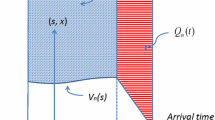Abstract
We study the convergence of finite-capacity open queueing systems to their infinite-capacity counterparts as the capacity increases. Convergence of the transient behavior is easily established in great generality provided that the finite-capacity system can be identified with the infinite-capacity system up to the first time that the capacity is exceeded. Convergence of steady-state distributions is more difficult; it is established here for the GI/GI/c/n model withc servers,n-c extra waiting spaces and the first-come first-served discipline, in which all arrivals finding the waiting room full are lost without affecting future arrivals, via stochastic dominance and regenerative structure.
Similar content being viewed by others
References
S. Asmussen,Applied Probability and Queues (Wiley, New York, 1987).
P. Billingsley,Convergence of Probability Measures (Wiley, New York, 1968).
A.A. Borovkov,Asymptotic Methods in Queueing Theory (Wiley, Chichester, 1984).
A. Brandt and B. Lisek, On the continuity of G/GI/m queues, Math. Operationsforsch. Statist., Ser. Statist. 12 (1983) 577–587.
S.N. Ethier and T.G. Kurtz,Markov Processes, Characterization and Convergence (Wiley, New York, 1986).
P. Franken, D. König, U. Arndt and V. Schmidt,Queues and Point Processes (Akademie-Verlag, Berlin, 1981).
D. Gibson and E. Seneta, Augmented truncations of infinite stochastic matrices, J. Appl. Prob. 24 (1987) 600–608.
V.V. Kalashnikov, The analysis of continuity of queueing systems, In:Probability Theory and Mathematical Statistics, eds. K. Itô and J.V. Prokhorov, Lecture Notes in Mathematics 1021 (Springer-Verlag, New York, 1983) 268–278.
V.V. Kalashnikov and S.T. Rachev,Mathematical Methods for Construction of Queueing Models (Nauka, Moscow, 1988) (in Russian, to be translated into English be Wadsworth and Brooks/Cole).
A.F. Karr, Weak convergence of a sequence of Markov chains, Z. Wahrscheinlichkeitstheorie und Verw. Gebiete 33 (1975) 41–48.
J. Kiefer and J. Wolfowitz, On the theory of queues with many servers, Trans. Amer. Math. Soc. 78 (1955) 1–18.
W. Ledermann and G.E.H. Reuter, Spectral theory for the differential equations of simple birth and death processes, Phil. Trans. Roy. Soc., London A246 (1954) 321–369.
S.T. Rachev, The problem of stability in queueing theory, Queueing Systems 4 (1989) 287–318.
D. Sonderman, Comparing multi-server queues with finite waiting rooms, I: same number of servers, Adv. Appl. Prob. 11 (1979) 439–447.
D. Stoyan,Comparison Methods for Queues and Other Stochastic Models (Wiley, Chichester, 1983).
W. Whitt, Embedded renewal processes in the GI/G/s queue, J. Appl. Prob. 9 (1972) 650–658.
W. Whitt, Some useful functions for functional limit theorems, Math. Opns. Res. 5 (1980) 67–85.
W. Whitt, Comparing counting processes and queues, Adv. Appl. Prob. 13 (1981) 207–220.
D. Wolf, Approximation of the invariant probability measure of an infinite stochastic matrix, Adv. Appl. Prob. 12 (1980) 710–726.
Author information
Authors and Affiliations
Rights and permissions
About this article
Cite this article
Heyman, D.P., Whitt, W. Limits for queues as the waiting room grows. Queueing Syst 5, 381–392 (1989). https://doi.org/10.1007/BF01225326
Received:
Revised:
Issue Date:
DOI: https://doi.org/10.1007/BF01225326




